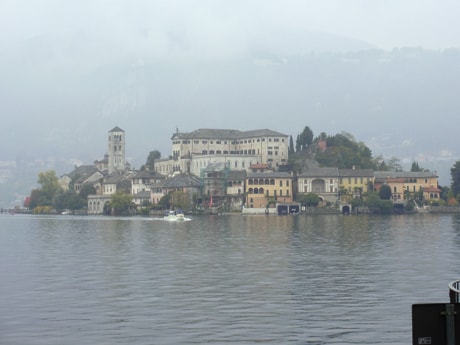The sleepy isle of San Giulio glistens like a jewel in the middle of beautiful Lake Orta behind the mountains of Mottarone in the most western lake of the Italian Alps.
A Benedictine monastery occupies the centre of the island and narrow stone houses and expensive summer villas push out from the centre towards the water’s edge, flowers hanging from their lacy wrought iron gates.
It is such a peaceful spot that it is known as the “Island of Silence” — a vastly different designation than it had during the fourth century.
Legend has it that the island was once infested with poisonous serpents and ferocious dragons. In the late fourth century, a Greek evangelist named Giulio got rid of the dragons and snakes, built a church and converted the people to Christianity. The island and the monestary were named San Giulio (Saint Julius) in his honour and the saint’s remains are still inside the island’s basilica.
From the promenade of the medieval town of Orta, you can watch boats coming and going from the little isle.
As we stepped off the tourist train next to the ancient piazza, we could smell the delicious aroma of chestnuts roasting over an open fire.
The piazza is the central area for a number of artistic and musical events in northern Italy and on this autumn day a group of people were gathered for a festival to support a local children’s charity. Fresh roasted chestnuts and mulled wine seemed like the perfect snack to enjoy while wandering the streets of the medieval town.
Other than the small tourist train, there are no motorized vehicles in the historical centre of the city. Everything about it invites you to walk; from the lakefront walkway to the cobbled streets that lead past little shops and sixteenth century houses. Quiet paths open up into squares and meeting places with benches and beautiful gardens.
We spent the better part of the morning wandering in and out of the little shops that line the streets of the medieval town. Wandering down a passageway towards the water’s edge led to the discovery of a tree-lined square known as the “sitting room square.” I stopped for a few moments and relaxed on a bench just taking in the view of the lake and its magical island.
In that moment, it was easy to see why this spot has inspired myths and legends. There are few places that can match the sheer beauty of Lake Orta.
It’s about the food
Autumn is a special season in Northern Italy when sights and sounds combine to create a feast for the senses. Nowhere is this truer than in Italy’s lake and hill country.
Whether you are enjoying the delicious flavour of roasted chestnuts along with a glass of mulled wine or sampling the world’s most expensive food — the Italian white truffle — you are sure to enjoy dining in northern Italy especially in the autumn months.
Here are just a few of the foods this part of Italy is famous for.
San Giulio Bread – You can only find Saint Julius’ bread in the bake shops of Orta. Named for the Saint, this flavourful bread contains walnuts, raisins, orange peel, and almonds.
Tapulon – Tapulon is a gastronomic specialty of the nearby town of Borgomanero, which is located about 15-km from Orto San Giulio. The traditional dish is made with finely chopped donkey meat, wine, garlic salt and olive oil.
According to legend, the town of Borgomanero was founded by thirteen peasants who were returning from a pilgrimage to the island of San Giulio. They were travelling on a cart drawn by a donkey. When one of the cart wheels broke, they halted their journey and decided to settle in that very spot. To celebrate the occasion, they killed the donkey – creating the first tapulon in history.
White Truffles - The Piedmont region of northern Italy is famed for the production of white truffles, a type of fungal fruiting body that grows underground like a tuber. White truffle season goes from October through December.
Truffles are best enjoyed fresh sliced thinly over eggs, vegetables, risotto or pasta.
Barolo Wine – Barolo is an Italian wine that is grown in the Piemonte region of Italy and is proclaimed by locals to be the “king of wines.” Only certain vineyards with clay soils and suitable slopes are considered suitable for Barolo production. Barolo wines that are aged for at least five years receive the status of Riserva.
Gelato – It is believed that gelato originated in northern Italy in the 16th century. Most stories credit Bernardo Buontalenti, a native of Florence with its creation. To this day, gelato remains one of gastronomic highlights of Italy and even though it has been introduced to other parts of the world, the best gelati can still be found in Italy. For best effect, one should sample a different gelato every day. (Note: Gelato may also be used as a meal replacement).
If You Go:
• Consider a stay at the Hotel San Rocco in the medieval town of Orta. Rooms have lovely views of the lake and the Isle of San Giulio. The restaurant is also excellent. Be sure to sample the risotto - the head chef won gold at the international culinary Olympics with his risotto recipe. For more information on Hotel San Rocco, visit: www.hotelsanrocco.it.
• For more information on visiting Italy, check out the Italian Government Tourist Board website at: italiantourism.com. You can find package prices for the Piemonte region of Italy by visiting: piemontenow.com.
Debbie Olsen is a Lacombe-based freelance writer. If you have a travel story you would like to share or know someone with an interesting travel story who we might interview, please email: DOGO@telusplanet.net or write to: Debbie Olsen, c/o Red Deer Advocate, 2950 Bremner Ave., Red Deer, Alta., T4R 1M9.
